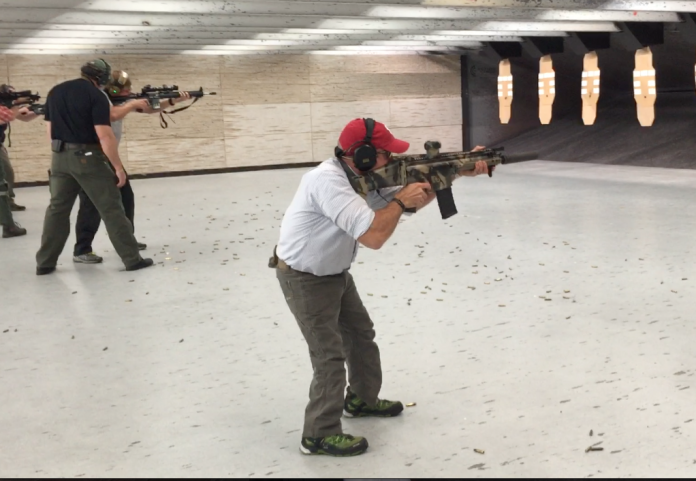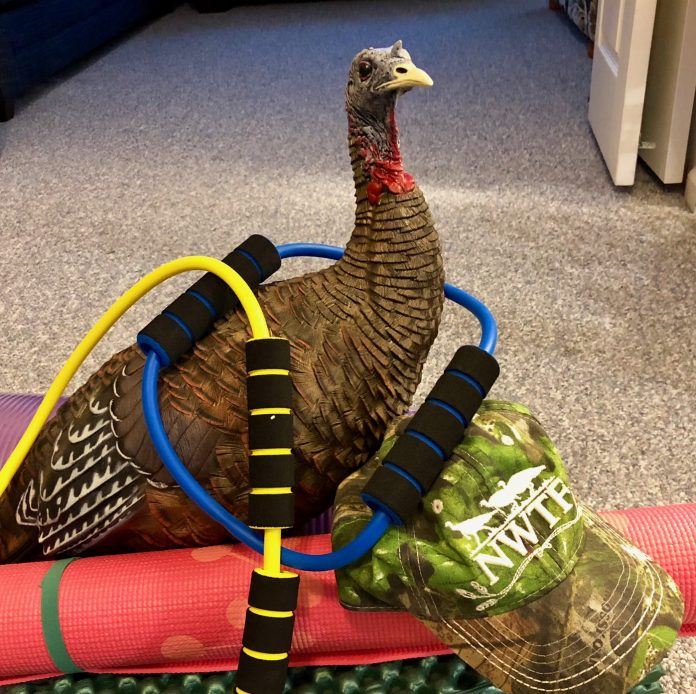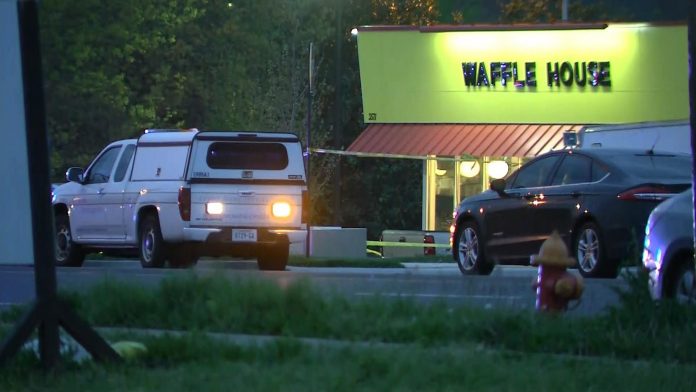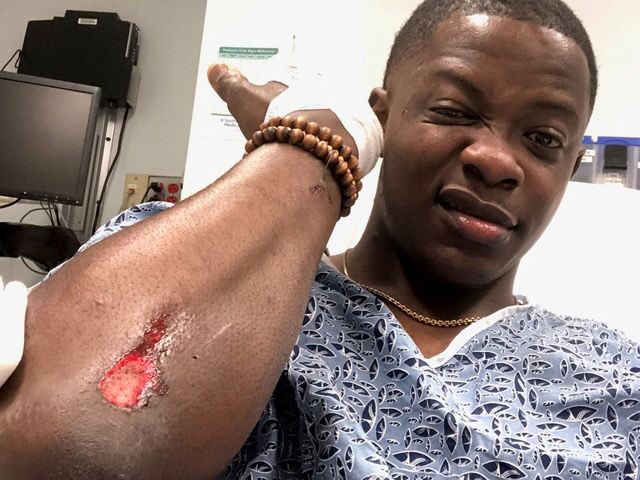Welcome to We Like Shooting’s Double Tap, Episode 57, Where we answer your questions, talk about new tech in the gun world, and touch base on gun industry news.
After Action Review (AAR) of Green Ops – Defensive Carbine for AR Platforms
By: Mark Farage – MASF Member
AAR: Green Ops – Defensive Carbine for AR Platforms I (09/20/15 – NRA Headquarters Range)
I don’t like reading long dissertation style after-action reports on classes so, I’ll try and keep this short, informative, and to the point.
Any time that I go check-out a new instructor / teacher, I always make it a point to take one of their basic courses. It’s a great way to be introduced to an instructor / teacher and it’s a great way for you to be introduced to them. Trust me, as an instructor / teacher myself, getting to know your students (their capabilities – strengths and weaknesses) is uber important. Also, if an instructor can’t teach the fundamentals well… well, that’s a bad sign. As such, I took the Defensive Carbine for AR Platforms I course from Green Ops last night at the NRA Range.

Overall, I was impressed by the course and will definitely take additional classes from Mike Green. The course opened up with some basic classroom information on defensive firearm use and safety information. I won’t bore you with the details…but the details are important…particularly in light of today’s litigious culture. Just know that the hour spent in the classroom goes quickly and you will be on the range soon.
Range time started with a 5-round zero course of fire and ended with a barricade shoot / no-shoot decision course of fire. In between those two courses of fire the group of ten students was broken down into two groups and the groups alternated between courses of fire and rest periods. The courses of fire included, but were not limited to: 1-shot ready drills, 2-shot ready drills, 1-shot / reload / 1-shot ready drills, 1-shot / reload / 2-shot ready drills, multiple-target transition drills, etc. All-in-all what you would expect from a basic carbine course.

I really appreciated the fact that we covered malfunctions but, we didn’t spend any actual range time on clearing malfunctions. In a 4-hour course format there just isn’t enough time to train on malfunctions. I know there are a gazillion different opinions out there on malfunction training but, in this area I completely agree with Mike Green, save the majority of your malfunction training for off-range time. In today’s busy world a lot of us have limited time to hit the range and that time is better spent shooting. I fully support malfunction training in more advanced classes, but a basic class shouldn’t get bogged down in malfunction training. As an aside, I’ve run a combined 50,000 rounds through my two primary guns (a Noveske MK18 and a SCAR CQC – yes, I’ve changed barrels, bolts, firing pins, springs, etc.) and I’ve only had a handful of malfunctions outside of those purposely induced by instructors / teachers. What’s the lesson; invest in good equipment if you’re going to trust your life or the lives of your loved ones to that equipment.

Mike is a really good teacher, he takes time to work with each student, his demonstrations were spot on and he does a great job of teaching “methods” and reiterating that “methods” are just that…”methods” on how to do something not “the only way” to do something. I was really impressed with the fact that he spent time with each student on each drill, giving pointers here or there depending upon the need (skill based). I was also impressed with Mike’s demeanor, he’s a good instructor / teacher and as a good instructor / teacher he didn’t feel the need to stroke his ego… I always like that in instructors / teachers. Being humble is a rare commodity these days… and Mike has that mastered. Mike also did a great job of fielding questions and answering them but, also keeping on point.
At the end of the day we all (well most of us) have limited resources, limited time, and limited ammo… so, would I recommend you investing in a training class with Mike; absolutely. There aren’t that many short-format courses out there and I think Mike has really filled a niche and the location for the DMV can’t be beat. A special thanks also goes to the NRA range staff for keeping everyone safe.

If you have any questions, let me know and I will answer them as best as I can based upon my experience.
-Mark William Farage

Biography:
Mark Farage is the founder of Farage Precision, LLC and a minority owner of Ronin Combat Strategies. Mark is a “teacher” with a highly diverse skill set honed from a wide range of experiences, travels, and training. His background includes, but is not limited to: competitive shooting, professional firearm instruction, extensive off-road experience, advanced first aid training, global travel, and, combative tactics. As a shooter he is an avid USPSA, IDPA, 3-Gun, 2-Gun, Precision Rifle Series, and Steel Challenge competitor and he gained practical firearms experience as a private military contractor working in the Middle East. In the area of vehicle dependent travel he has participated in off-road adventures from Columbia to Vietnam, he’s been getting off of the beaten path for over 20 years, and he has a reputation for building some of the most capable overland vehicles ranging from Land Rovers to Toyotas. He has attended numerous driving and recovery schools and is well versed in a full-spectrum of vehicle operations. Mark has also traveled the globe and visited every continent with the exception of Antarctica.

Mark has extensive experience working for international corporations in the area of global risk management, fraud mitigation and resolution, and corporate criminal investigations throughout North and South America, Asia, and Europe. His investigations have led to the prosecution and imprisonment of individuals on the local, state, and federal level. Mark currently works for a publicly traded company in the Washington, D.C. Metro area and continues to maintain industry contacts in the off-road, firearms, military, and medical community. Mark has an undergraduate degree and Masters of Business Administration from Christian Brothers University; he is a Certified Internal Auditor, Certified Fraud Examiner, Certified Information Systems Auditor, and a NRA certified firearms instructor.
Mark is an adventurer at heart and does not let his Osteogenesis Imperfecta prevent him from enjoying and thriving in life. Mark enjoys CrossFit, climbing, hiking, fishing, camping, wrenching on his off-road vehicle, and reading when he is not knee-deep in an adventure.
SOURCE ARTICLE: http://masf.co/2016/08/17/after-action-review-aar-of-green-ops-defensive-carbine-for-ar-platforms/
AR500 Armor Wants You in PE!
Polyethylene
The fine folks of AR500 dropped me a line that their latest addition to their rifle armor offerings is on sale.
Seriously on sale.
Like an exceptional Testudo carrier and UHMWPE plates for less than a pair of plates normally on sale.
Ultra High Molecular Weight Polyethylene offers a lighter weight, greater mobility, increased comfort load out of rifle rated hard armor and AR500 has them ready to go.
These continue to ride as my standard plates. In case you missed the review it’s here.
And below.
There is a universal truth to armor.
It sucks to wear.
The materials capable of stopping a bullet or shrapnel impact and imposing it between you and that potentially lethal puncture/energy transfer usually carry the characteristic: HEAVY.
The affordable steel plates that AR500 Armor is known for weigh 8lbs each. Combine that with necessary trauma padding or soft armor and a carrier you quickly push 25lbs in a hurry. The level IV selection of composite ceramics provide better protection but no savings in weight.
The stereotypical response to a complaint about armor is “It’s supposed to be comforting, not comfortable.” In short, the burden of armor is a necessary discomfort for the protection. A balancing act of mobility against the ability to stop an impacting gunshot. It ironically makes you a little slower and easier to hit, especially on an unconditioned body. Physical education and conditioning make armor bare-able.
However, thanks to science, we continue to develop and apply materials that do things better.
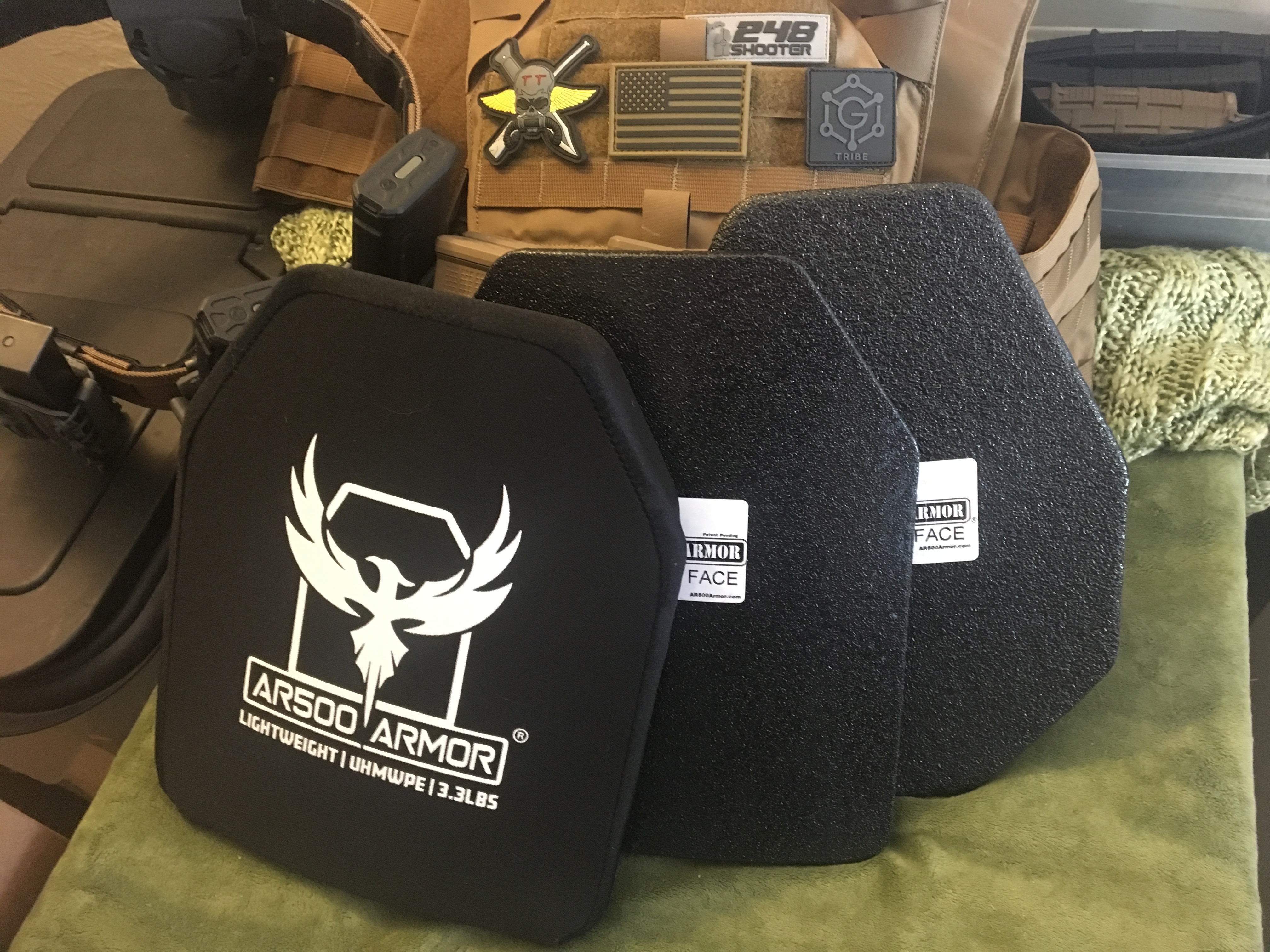
Ultra High Molecular Weight Polyethylene (UHMWPE) offers us several material advantages.
Polyethylene? Yes.
Plastic? Yes.
Ultra-high-molecular-weight polyethylene (UHMWPE, UHMW) is a subset of the thermoplastic polyethylene. Also known as high-modulus polyethylene, (HMPE), it has extremely long chains, with a molecular mass usually between 3.5 and 7.5 million amu.[1]
The longer chain serves to transfer load more effectively to the polymer backbone by strengthening intermolecular interactions. This results in a very tough material, with the highest impact strength of any thermoplastic presently made. –Wikipedia
UHMWPE is odorless, tasteless, and nontoxic.[3] It embodies all the characteristics of high-density polyethylene (HDPE) with the added traits of being resistant to concentrated acids and alkalies, as well as numerous organic solvents.[4] It is highly resistant to corrosive chemicals except oxidising acids; has extremely low moisture absorption and a very low coefficient of friction; is self-lubricating (see boundary lubrication); and is highly resistant to abrasion, in some forms being 15 times more resistant to abrasion than carbon steel. Its coefficient of friction is significantly lower than that of nylon and acetal and is comparable to that of polytetrafluoroethylene (PTFE, Teflon), but UHMWPE has better abrasion resistance than PTFE.
UHMWPE is 8-15 times stronger than steel in strength to weight. It also has a very high chemical neutrality resisting water, oils, and solvents. It’s molecular strength is extremely high but actual density low, making it buoyant.
The polyethylene is made into long molecular aligned fibers and woven into a sheet. When layered with other sheets it allows for exceptional energy transfer reduction between the molecules and layers. The sheets are oriented in varying directions further increasing the overall property strengths of the UHMWPE as the aligned fibers crisscross.
The layers and dissonant orientation of the specialized polyethylene form an energy absorbing ‘catcher’s mitt’ plate that successfully stops rifle rounds. NIJ Level III rated stopping 7.62x51mm (.308), 7.62x39mm, and 5.56x45mm (.223 Rem) multiple hits stand alone (does not need to have a soft armor or carrier component to function). UHMWPE would be a worthy armor candidate on fewer property merits but when the material is formed into 10×12 armor plates they weigh less than half their conventional level III and level IV counterparts.
3.3lbs each and buoyant (won’t sink in water) cuts the overall weight of a kitted carrier down by around 50% while still maintaining level III protection.
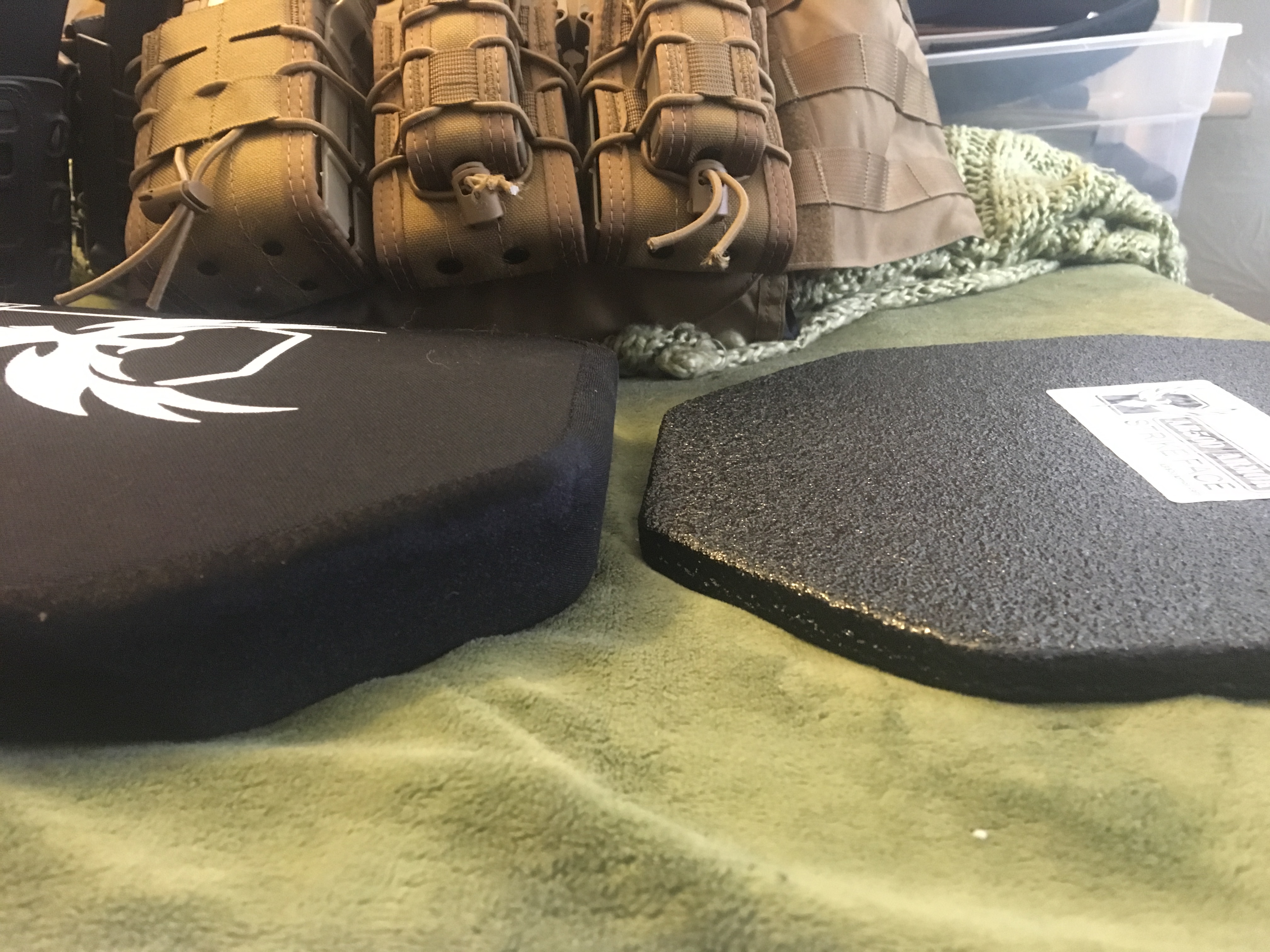
Physically the plates are higher volume but most carriers like my Valkyrie have enough room to accommodate them without issue.
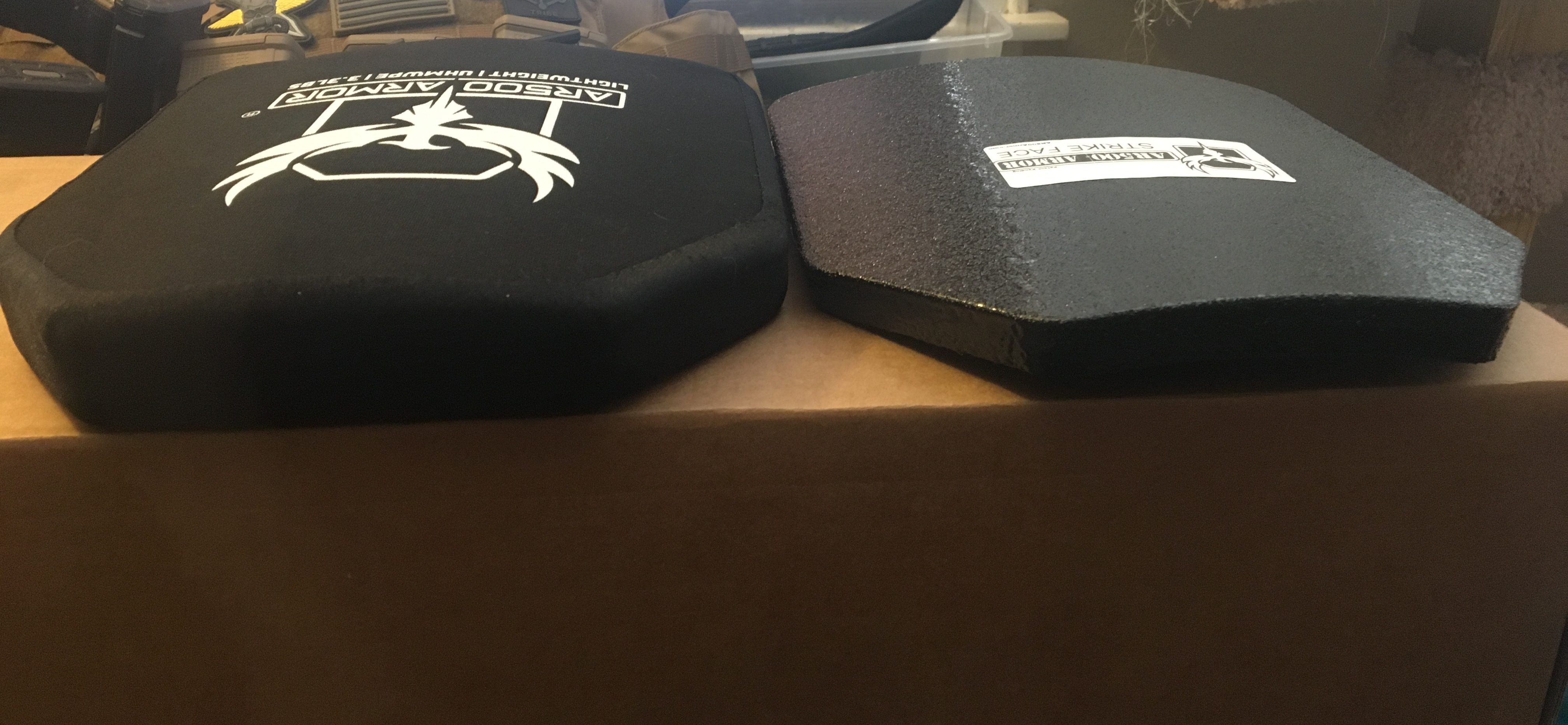
The thick light weight plates are also significantly less fragile than level IV ceramic.
Ceramic body armor plates are fragile, to a degree, being designed to catch a high velocity projectile from the front (or back) strike face. The layered ceramic is designed to crush and break, catching impacting rounds. Once it is broken the plate needs replacement. Ceramic is still a glass product and if dropped, sat on, or torqued in a way that cracks the layers they are now compromised.
The polyethylene (plastic) plates aren’t as vulnerable to unintentional damage from rough handling.
If considering any maritime application the buoyant water proof plates will not sink a water bound wearer or be compromised by immersion. The coast guard, any harbor or coastal deputies, and in any other emergency or duty armored application near water UHMWPE benefits the wearer if they end up in the water.
Putting UHMWPE Polyethylene plates into your armor set up increases comfort, durability, mobility, and water safety (where relevant), while significantly decreasing physical duress and kit weight. Unless you’re requiring a level IV threat protection the PE plates have substantial advantages in a carrier.
It’s an armor material selection or upgrade worth serious consideration, currently my standard plates. They suck much less to wear, almost comfortable.
“No one sweats into their armor or has to go into the rain or water while wearing it and no one uses oils and solvents around firearms while wearing armor. It certainly isn’t heavy and doesn’t cause discomfort so I’m not sure why any of this is advantageous.” – Marine Veteran, after going for a swim with a rifle while in body armor now cleaning said rifle as the heavy SAPI’s and carrier chafe
Get Me a Medic – Stat!
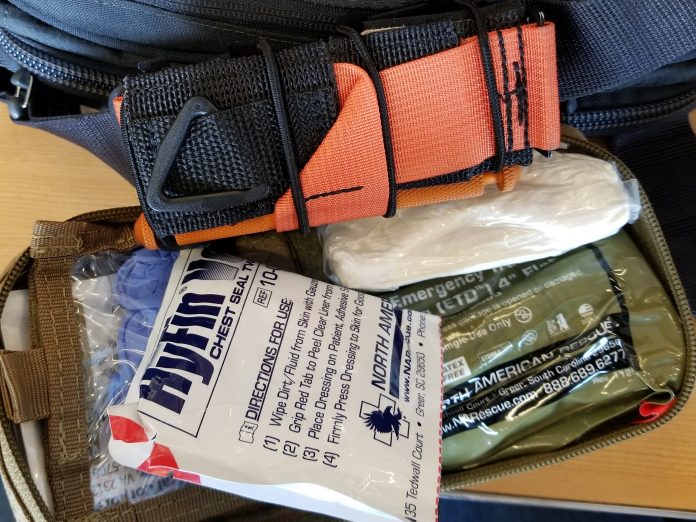

Medical is one of the hot topics in the self-defense training industry. With mass shootings, vehicle attacks on pedestrians, and other violent events in the news constantly, it’s becoming an increasingly popular topic everywhere else too. Carrying a gun or other weapons isn’t for everyone whether for legal or other reasons. Having the knowledge and tools for first aid? There are no restrictions on owning and carrying first aid supplies. You should join the crowds who are adding medical training and equipment to your life. Here’s why.
When Seconds Count…
It’s not just armed response that is minutes away at best. It’s also any chance of medical intervention in the moments that matter after a violent injury or even common yet major health events like allergic reactions, heart attacks, and strokes. If you are prepared to be the person on the spot in your fantasy of saving a crowd from a mass shooter, you should also be prepared to be the person on the spot with the higher likelihood event of an injury or illness that requires immediate help. The standard of care is fifteen seconds to get a tourniquet on to control massive hemorrhagic bleeding. And if it’s you leaking blood, you might want to get on it yourself.
Do Something!
Nobody likes to feel helpless. Interventions as simple as direct pressure can control blood loss long enough to make a difference. And even if it doesn’t, knowing how and being able to take action means you were able to try. You were able to do more than stand by and watch someone die. That’s not something I can live with, and it’s something you should think about before you skip yet another opportunity to take a first aid class.
If I Can, You Can
One of the beauties of medical training is that many immediate first responder techniques can be easily learned by anyone. You don’t have to wait for a class to fit into your schedule either. A few minutes with a YouTube video can get you started. A quality in-person class like Bleeding Control is only a few hours and covers all of the basics.
Much of what’s useful for equipment is both affordable and easily carried. You don’t need to plan to improvise when a CoTCCC recommended tourniquet is $30 from a reputable supplier, can be carried in a back pocket, and is proven effective. My SOFTT-W goes almost everywhere with me and if I’ve figured out how to do that, a little creativity on your part will get you there too.
Sh!t Happens
It’s not unusual to focus on gunshot wounds as a leading cause for needing medical help right away. They’re not the only reason why first aid is needed in everyday life. Even in the sexy trauma first aid realm, where we get to use tourniquets, slap on chest seals, and shove hemostatic dressings into holes, there are many other reasons why we might have to get to work.
How many of you work around heavy machinery? Factories are one thing, but limb-crushing injuries can happen at construction sites, warehouses, work yards…you get the idea. How about motorcycles? Even if you don’t ride, pay attention to who you’re sharing the road with on the next warm day. Now think about what might happen if a leg gets trapped between bike and car or asphalt. If a big piece of debris is kicked up by a passing car or flies out of a truck bed and spikes itself into a rider, or even a pedestrian.
And those are just the bloody injuries or the blunt force traumas. They’re not the only things that go wrong. For instance, do you have a child or co-worker who is allergic to bees, peanuts, something else? Anaphylactic shock is deadly, sometimes in minutes. Knowing where an Epi-Pen is and how to administer it can save a life.
IT SAVES LIVES
We’ve learned some hard-won lessons from the War on Terror, and we can respect them by not allowing people to die from preventable causes. In the Tactical Combat Casualty Care – All Combatants class I recently took, one of my instructors was living proof that what we were learning that day works. He couldn’t stand in front of us because both of his legs were traumatically amputated in Afghanistan. Two CAT tourniquets saved his life with minimal blood loss. His story is worth a few minutes of your time:
We would like to offer our profound thanks to Adam Hartswick and the crew of DUSTOFF 68 for sharing their story and hope that it will inspire and educate as many people as possible so that more lives are saved in the future. ***Be aware that the following footage from the incident is GRAPHIC.Sgt. Adam Hartswick was deployed to Afghanistan with 3-41 Infantry, Alpha Company, when his life was forcefully altered by a devastating attack on his unit May 14, 2013. "I was the company senior medic (68W) responding to an attack on our second platoon," Adam said, recalling that day. “I wasn’t even supposed to go outside the wire that day. I had guard duty, but when I heard that my guys had been hit – I had to go.” Adam jumped into the back of a responding QRF vehicle and rushed to aid his teammates."When I arrived at the scene I immediately discovered that my junior platoon medic, SPC Cody Towse and two other Soldiers were dead.” After the initial explosion, Cody had rushed to aid SPC William Gilbert and SPC Mitch Daehling. William had been killed instantly in the blast, but Mitch was still alive and critically injured. As Cody attempted to treat Mitch, he placed his med ruck on the ground and triggered a second device that killed them both instantly. Cody was posthumously recognized for his heroism and awarded the Bronze Star. Arriving on scene with the QRF, Adam worked to set up his CCP and treat the wounded."I was doing human-remains recovery and treating the walking-wounded when the [Explosive Ordnance Disposal (EOD)] team showed up," he continued. "The EOD team leader Sgt. 1st Class Jeff Baker came up to me and put his hand on my shoulder, looked me in the eye, and calmly told me, ‘We’re going to save our brothers.’ Moments later he went to interrogate a device and it blew up, killing him about ten meters in front of me." Adam suffered minor injuries from that explosion but was able to continue his medic duties."I shook that off and went to retrieve him when I was blown up," he said. “It felt like I got hit by a truck! My body was ringing like a tuning fork, but I was still conscious, so I treated myself. I was able to get one CAT (tourniquet) on good and tight but I was missing an index finger and putting that TQ was the hardest thing I’ve ever done. Thankfully the platoon leader was competent in TCCC and came to me (in spite of the danger of other IEDs) and applied a second CAT on my other leg and reassessed and tightened my initial tourniquet.” The blast from the IED had critically wounded Adam. “My body was a wreck – I had: bilateral transfemoral amputations, right index finger amputation, partial right thumb amputation, large lacerations on right arm, bilateral perforated eardrums, fractured right hip, mild TBI, various shrapnel wounds, and bruises all over my arms and legs. Somehow I had no torso trauma, no facial trauma.” In what would later be recognized as the 2013 Dustoff Rescue of the Year, DUSTOFF 68, C/2-3 GSAB, Hunter AAF, GA (CPT Douglas Hill, 1LT Kelly Ward, SGT Robert Silva, SGT Jason Daniels, and SGT David Hixson), plucked Adam and a wounded teammate from the IED strewn battlefield and raced them to Role 3 care. Remarkably, despite having both legs being traumatically amputated, Adam remained conscious without any pain management until he reached the Role 3 OR where he continued to joke with nurses until he was anesthetized.Six days later, Adam was back in the United States at Walter Reed Medical Center recovering from his injuries. Adam’s father, himself career Army, slept in a chair next to his son’s bed for the weeks that it took Adam to fight his way out of intensive care. Today, ever thankful for his second chance, Adam works tirelessly to spread the TCCC gospel through his role as a TCCC instructor with Techline Trauma. As Adam puts it, “Every gunfighter needs to be trained to be a medic and every medic needs to be trained to be a gunfighter.”Reposted from North American Rescue.
Posted by Stay The Course on Thursday, March 23, 2017
After watching that, I couldn’t look Adam in the eye and not be a true believer in the value of quality medical training and equipment. How about you?
We Like Shooting 239 – Both Places
Welcome to the We Like Shooting show, Episode 239 – tonight we’ll talk about , AR pistols, california compliant mag system, vertx, Shield Sights, and more!
Just a Girl and Her Decoy
I know this isn’t the usual review article, but I figure if you can’t keep a sense of humor while you are deep in the learning curve of a new activity then why bother.
As I’ve mentioned before, I am a novice hunter, and hope to bag my first spring gobbler during the rapidly approaching local season.
As part of my initiation into the cult of this avian adversary, I attended my local National Wild Turkey Federation dinner about a month ago. During this initiation “ceremony”, I was parted with many of my dollars. These dollars were spent on various games of chance which taunted my greed with promises of new shotguns. There were new calls and additional chances to win handguns and gear with which to bag my own specimen of the revered quarry. All of this to benefit the habitat and preservation of Meleagris gallopavo. I placed bids on many items, and kept my fingers crossed. Annnnd what did I come home with?
A glorified rubber chicken.
I’m teasing of course. This was a top-of-the-line Avian X hen decoy and I was tickled to have ANY decoy to start out my turkey career. But I could not get over a neophyte’s sense of the absurd about the whole thing – especially when I read the directions for use.
I was first of all required to allow my hen decoy to “come to room temperature”. Well, I don’t really like to be messed with much when I’m cold either, so I suppose I could understand that. Then, I was instructed to locate the air valve on the bottom of the decoy, and pull out the valve stem. Wait, I thought this was a hen? She has a “stem”? And I’m supposed to put my mouth there and, and … inflate her? This was too much for my inner middle-schooler, who dissolved into a fit of the giggles. But wait- there’s more.
The next step instructed me to place my newly inflated hen IN A HOT SHOWER… FOR TEN MINUTES. Let me tell you, after inflating an expensive rubber chicken with my mouth, I kinda felt like I needed a shower too – either that or I needed a Groucho Marx mustache. But the post-shower results were JUST GORGEOUS!
She is so realistic that I decided to give my hen turkey a name. I’m calling her Henrietta. Original, I know. But now I’m going to feel like a bit of a pimp. I mean, I’m going to be out there showing her off to the tom turkeys. I want pretty little Henrietta to get them excited enough to throw caution to the wind and strut right into the path of my shotgun. I feel dirty already.
I suppose I could think of this in a more positive vein. Maybe I should think of Henrietta as an undercover cop on a prostitution sting. Her job is to look and act alluring and available, and my job is to bring the lecherous John – I mean Tom – to “justice”. In this case, “justice” being the death penalty by 12 gauge, with post-mortem incarceration in my freezer. Tasty justice.
To help with my feelings of guilt about pimping out my new friend and because I’ve got a gimpy post-op hand and thus am bored, I wanted to feature Henrietta in a few “get to know you” photo-ops while we both work on our pre-season training. If she’s going to be my wingman – I mean hen – then we need to train together.
Here’s Henrietta lounging on the couch after her shower.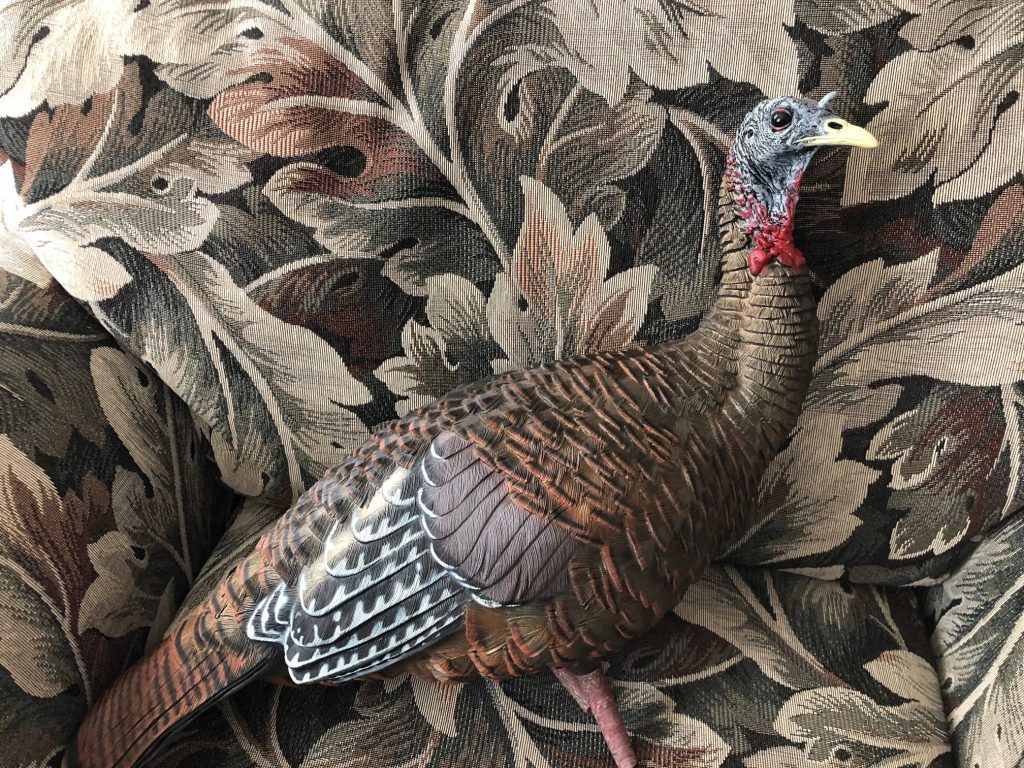
This is us studying-up our NWTF magazine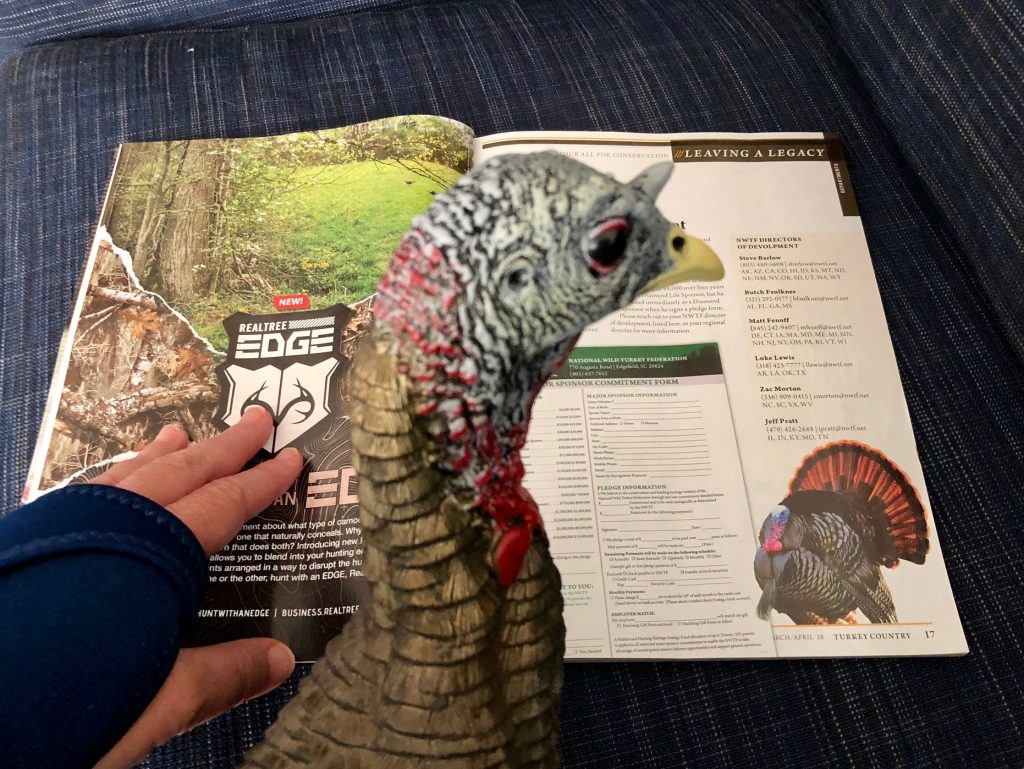
This is Henrietta critiquing my calling – “No. No. No.” She says, “Your accent is all wrong. Repeat after me, The rain in Spain falls mainly in the plain.” 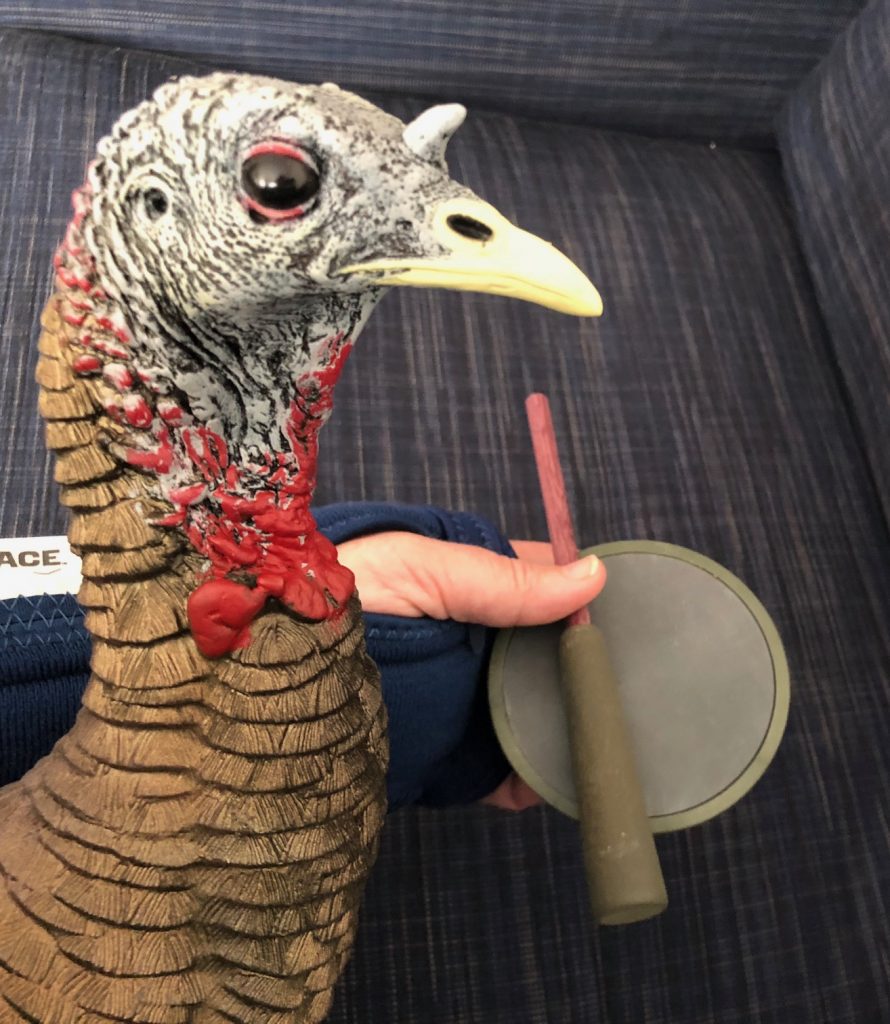
Her look says it all – You CAN’T be serious.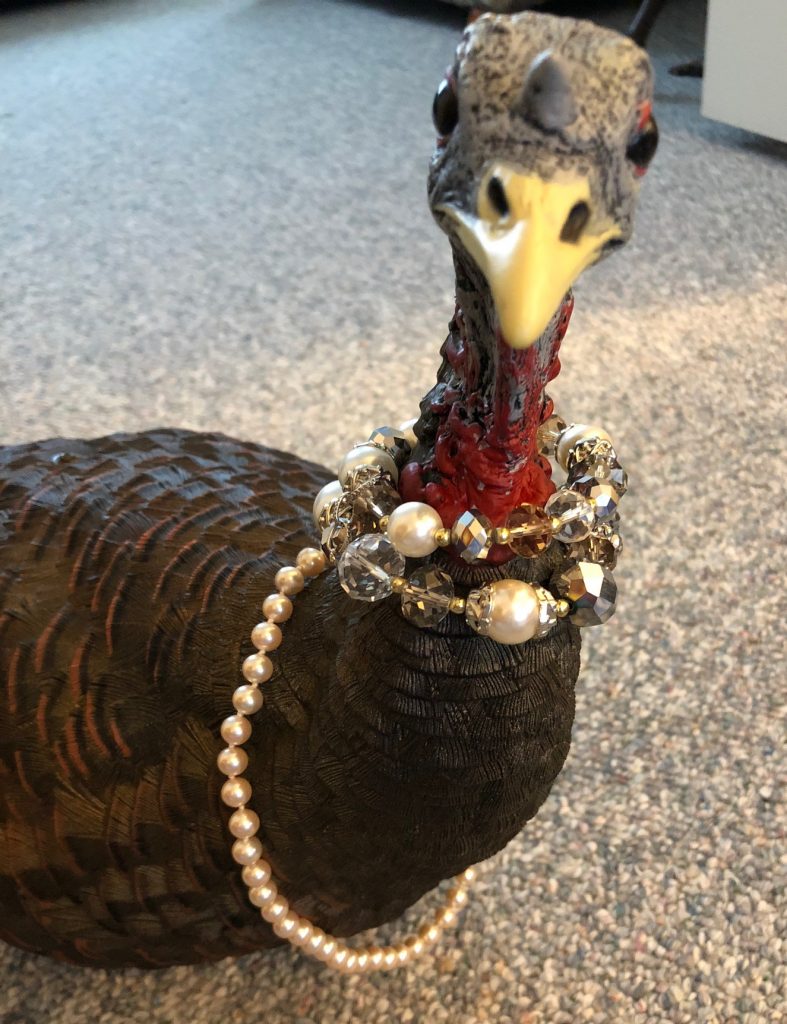
Henrietta and I have done pretty much everything but the Chicken Dance to get ready for the season. Come to think of it, maybe I could talk her into practicing “My tailfeather shake brings all the Toms to the yard”.
I sure hope it will. Wish us luck.
HOW TO CLEAN YOUR SHOTGUN WITH SWAB-ITS
When it comes to maintaining firearms, Swab-its’ Bore-tips offer improved barrel cleaning and lubrication while the Gun-tips line offers four distinct sizes and lengths of swabs to ensure cleaning and lubrication of the harder to reach areas that are often neglected. Reusable and easy to clean with soap and water or mineral spirits, Swab-its products are more thorough, quicker and easier to use than traditional methods of firearms cleaning and do not leave the residue or lint left behind by patches, mops and cotton swabs.
Before You Clean Your Shotgun
Visually and physically inspect to insure the firearm is unloaded. No ammunition should be present while cleaning. It is advisable to have your manufacturer’s owner’s manual handy for reference for proper disassembly and maintenance procedures. If you purchased your gun used, many manuals can be downloaded by accessing the manufacturer’s website.
What you need: shotgun rod, solvent, lubricant, Swab-its Bore-tips in correct gauge, Swab-its 9 piece Gun-tips, a rag or paper towels. In this article, we address cleaning the Over-Under Shotgun. To demonstrate, we will clean and lubricate a Beretta Silver Pigeon.
Disassemble the firearm according to the manufacturer’s instructions. Essentially, you should have three pieces: the receiver with the stock, the barrel and the forend. Select the appropriate gauge Bore-tip, they are available in 12 gauge, 20 gauge, 28 gauge and .410, and apply solvent/cleaner. Keep in mind that the Bore-tips are quite absorbent and require less fluid than you may normally use with a mop.
Working from the breech end, push the Bore-tip through the chamber, forcing cone and barrel. Wait for the solvent to soften the fouling. Most solvent manufacturers recommend 10-15 minutes.
Brush the barrel with the appropriately sized brush and then use the Bore-tip to reapply additional solvent. Repeat the process.
Using the same Bore-tip, mop out the fouling by running the swab through the barrel and blotting off on a paper towel or rag. Most of the fouling will have been removed. At this point, thread on a clean, dry Bore-tip and run it through to remove residual solvent and fouling. This will dry the barrel. Take the remaining Bore-tip and apply lubrication, if desired. Remember, this must be removed before the next time you fire your gun.
Bore-tips are washable and reusable. To save hassle, the lubricating swab can be placed in a zip lock and continued to be used for lubrication only in the future, as long as it is not contaminated by solvent. The swabs that were used for application of solvent and removal of fouling are easily cleaned by either dipping them in mineral spirits, blotting and allowing to evaporate dry, or, washing with a degreasing dish soap, such as Dawn. If using dish soap, allow sufficient time for complete drying before reusing. When using a bio-based product, cleaning with dish soap will work best.


The 5” large surface Gun-tip (olive green handle) can be used to clean under the ejector/extruder. Accessing the locking lugs and recesses is most easily achieved with the 3” precision tip Gun-tip (grey handle).


The same swabs are ideal for swabbing the frame and frame recesses. The 3” mini tip Gun-tip (brown handle) can also be used on the frame recesses.
Be sure to clean beneath the forearm bottom metal, using the 5” Gun-tip.

Remember: If you are storing your firearm and coat the barrel with light lubrication, this lubrication MUST be removed prior to shooting your gun.
By Michele Makucevich, Firearms Products Territory Manager of Swab-its. She oversees the Rhode Island CMP and is a long-time youth coach and competitive shooter.
SOURCE ARTICLE: https://www.agirlandagun.org/clean-shotgun-swab/
BREAKING: Possible Gunfight in the Region being searched for Reinking, UPDATE: Reinking in Custody
From Blue Lives Matter. Noise of a possible gunfight, rapid gunfire, from the region of Tennessee where the ATF and local authorities are looking for the at large Reinking.
Officials have announced a press conference. More at the link.
UPDATE
BREAKING: Murder suspect Travis Reinking is in custody. Arrested moments ago. – Metro Nashville PD
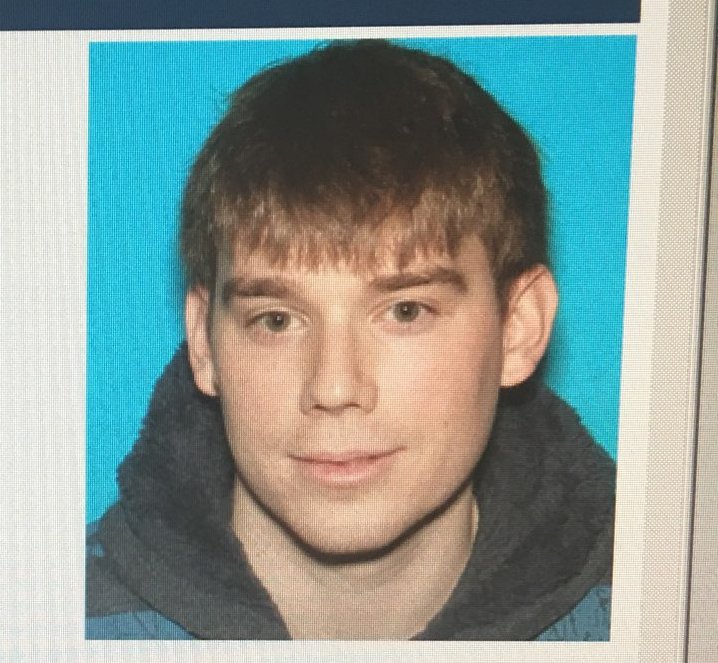
The Waffle House
On Sunday morning another mass shooting awoke the nation.
An Antioch Tennessee Waffle House was attacked at 3:23 am by Travis Reinking

Reinking, an Illinois resident, was carrying an AR-15 he had purportedly previously owned but was confiscated after he was arrested by the secret service in Washington D.C. for trespassing in restricted areas. The firearm was allegedly returned to him by his father after it was released to the father by local police some time after the D.C. arrest and later confiscation.
Reinking is a prohibited person. His FOID in Illinois was revoked.
To make the tragedy more bizarre Reinking was naked, except for a jacket, when he open fired killing two outside the restaurant and killing two inside before James Shaw Jr. (pictured), while wounded, yanked the rifle from Reinking and stopped the attack.
Reinking then fled naked on foot into the early morning, leaving his vehicle. He is still at large.
James Shaw Jr, the hero of Antioch, was a man who acted decisively saving his life and the lives of many in the restaurant and perhaps the wider area.
Emma Gonzales, a prominently featured survivor of Parkland, began accusing the NRA of schilling the incident to increase gun sales, alleging they were going to claim that the naked gunman had mental health issues.
Speculating the man who attacked a Waffle House at half past three in the morning while naked, with a previous arrest for trespassing in restricted areas of Washington D.C. allegedly trying to set up a meeting with the president because you do that by sneaking through the White House, might have mental health issues is apparently schilling and projectionist.
But it was absolutely because he was white and male.
She additionally claims that Mr. Shaw’s heroics prove nobody needs a gun to stop a mass shooter and that would hurt Smith & Wesson’s narrative.
I’d hazard that had Mr. Shaw been carrying an M&P Compact he might have been able to act more quickly and with greater equalizing force than waiting for Reinking to stop shooting and then riskily engaging hand to hand.
You do not need a gun to stop a mass shooter… It certainly helps though.
Emma’s assertion is that it is morally superior to attack a homicidally violent and well armed person from a position of extreme disadvantage because carrying or even owning your own weapon lawfully is apparently what caused the attack in the first place.
Her last claim was probably the most outrageous. That Mass Shootings only happen within the gun saturated streets of the United States.
The FBI defines a mass shooting as 4 people killed (not including the shooter). Mass shootings occur in churches, in schools, at concerts, in waffle houses – just about anywhere. Except in other countries. – Emma Gonzales
She must have missed these.
1. 2017 Egypt Mosque, 305 Dead <- ‘Church’ (Place of Worship) in another country.
2. 2014 Kenya University College, 148 Dead <- School in another country.
3. 2015 Pakistan School, 141 Dead <- Another school in yet another country.
4. 2015 Paris Attacks, 130 Dead <- Concert in another country.
5. 2011 Norway Attacks, 77 Dead <- Attack on a summer camp with a Mini-14 and Glock handgun after an earlier bombing.. oh and it’s in another country.
6. 2013 Kenya Shopping Mall, 67 Dead <- Four NRA Members attacked Westgate Ohio because they owned guns… no wait this was 4 Al-Shabaab terrorists who attacked a shopping mall in Westgate, Kenya. They were shot and killed after a 2 day battle with Kenyan armed forces and unconfirmed Israeli IDF support. Does this hurt Gonzales ‘you don’t need a gun’ narrative? They used a lot of guns.
Ryan Saavedra attempted to correct her assertion. The effectiveness of factual evidence to the gun control advocate is minimal however, we do appreciate the effort though.
We Like Shooting Double Tap 056 – A Savage Party
Welcome to We Like Shooting’s Double Tap, Episode 56, Where we answer your questions, talk about new tech in the gun world, and touch base on gun industry news.
Pat Rogers Final Speech
This was the final speech that legend Pat Rogers ever gave. It was at the Great American Outdoor Show in 2016.
This video was supplied by an MASF member, Andy Lander of GreenOps and his wish was to have it dispersed far and wide for all to see. Please watch, share it and help spread Pat’s legacy.
Also see -> Tribute to Pat Rogers, Brother, Mentor and Friend. Rest in peace.
SOURCE ARTICLE: http://masf.co/2016/10/17/pat-rogers-final-speech/
We Like Shooting 238 – Lawyers Guns and Money
Welcome to the We Like Shooting show, Episode 238 – tonight we’ll talk about Guy in a Garage, Vortex Optics, Faxon Firearms, Second Call Defense and more!
We Like Shooting Double Tap 055 – Krieger Clones
Welcome to We Like Shooting’s Double Tap, Episode 55, Where we answer your questions, talk about new tech in the gun world, and touch base on gun industry news.
Training, find out what you don’t know
By: Allen Sams, Owner Concrete FX – MASF Member
Originally Published in MASF Quarterly Online Magazine Fall 2015 issue
I share a similar firearms background with many people from a rural upbringing; I got my first BB gun when I was nine, shortly after that I went hunting with my dad and I was carrying my own gun before I got out of elementary school. Like many guys my age, and in my area, I grew up handling and shooting guns.
As soon as I turned 18 I convinced my father to purchase a pistol for me (though I paid for it, of course). It was a Ruger single six, but it was still a pistol. Several years later I got my first semi auto pistol and I was hooked.
Fast forward to getting my concealed carry permit, I took the then required course, bought a holster and I was ready to defend my family and myself if the need ever arose, or so I thought.

Another 12 or so years later a friend of mine stopped by my house on the way back from a pistol class with John Murphy of FPF. My friend started telling me about the class and how much he learned and how I should go to one. I couldn’t really understand what I could possibly learn about shooting that would warrant giving a stranger $450-$500 and burning up 1000 rounds of ammo. After all I shoot great and I’ve been shooting most of my life.
That friend was Baraka James, founder and owner of MASF, and he didn’t let up on the whole “we need to get you to a class” thing. Eventually F3 Tactical hosted a class put on by Magpul Dynamics, led by Steve Fisher, at Tango Down range in WVA. The range was 1.5 hours away but Baraka wore me down and I finally signed up.
I am not a person that gets intimidated or has a problem meeting new people, but it is a little unnerving showing up to your first class and taking the line for the first time with 18 other people. By the way, who the hell starts off a pistol class on the 25-yard line, oh yeah the Yeti does. Starting at the 25, and the reasoning behind it, was only one of 100 or more things I learned that day.

There was quite a mix of people there, some LEO some military, several people Beretta sent for R&D, and some of us civilians. Most of us probably thought we were competent shooters (and several I’m sure thought they were much better) but in short order it was proven to us that we all needed some serious work. The interesting thing is we all came along and by the end of the two-day class everyone had progressed well and had some mastery of all the skills taught.
I know trying to convince a gun guy that grew up shooting and hunting that they are probably not competent to carry their concealed weapon is not going to gain you any fans, but it is probably fact. I assured Baraka several times that in my years of shooting and handling firearms I was good to go. Fifteen minutes into that first class I actually had a weird epiphany. I knew that I never had any business carrying a concealed weapon falsely believing I was going to use it in defense of myself or others, without this kind of training.
 The problem with telling your friends or other people that they need training is the first question you’re asked will be, “What do they teach you?”. The hard part of that question is you can’t tell someone until they themselves know the answer.
The problem with telling your friends or other people that they need training is the first question you’re asked will be, “What do they teach you?”. The hard part of that question is you can’t tell someone until they themselves know the answer.
I don’t mean to sound like a fortune cookie, but it really is true. Until you start training with a good competent instructor you don’t know how important it is to learn the things you don’t know. Matter of fact, you most likely don’t even know how to practice.

I mentioned my epiphany earlier and I would like to elaborate on it. Until that first class I never thought about a malfunction drill, let alone practiced it. Most of the time I practiced I did not do it from concealment, which is the reason for the permit right? I never practiced speed reloads, worried about ammo management. When you’re in your back yard and you run dry you leisurely reload and continue shooting right? Just like in sports, you play like you practice, but if you ever need the skills we train to build, the stakes are much higher so our practice is that much more important.
One of the biggest eye openers was realizing that in defensive shooting marksmanship is about 10% of the equation. It’s the manipulations and compartmentalizing that I never thought about before. They make up the other 90%, and can be the hardest to master and make second nature. It is amazing what a drill incorporating speed reloads will do to your group size (it’s not good), learning to “shoot when you’re shooting and load when your loading” is a little harder than it sounds, at first. Learning malfunction drills is eye opening, running them until it is your first instinct to immediately clear your weapon, and not just stare blankly at it for a second or more, is the goal. Clearing concealment, draw stroke, presentation, all things that matter and all things you can’t get right until you are taught right.
My daughter is lucky that I had this epiphany when I did, becauseshe has benefited from learning every new weapons  system from a great instructor. She has taken essential handgun, carbine, and shotgun from Steve Fisher at Sentinel Concepts. Not only is Steve an awesome instructor, but also that is where she learned her fundamentals on each weapons platform before she had a chance to acquire training scars. Before we would go to a class I would familiarize her with her firearm and go over safety and her weapons controls and leave the rest to Steve. As a result I now have an 18-year-old little girl, who looks like she is 12, that is a straight up badass in three weapons platforms. Watching a kid or new shooter learn from a pro and progress so much faster than experienced shooters with bad habits is truly awesome.
system from a great instructor. She has taken essential handgun, carbine, and shotgun from Steve Fisher at Sentinel Concepts. Not only is Steve an awesome instructor, but also that is where she learned her fundamentals on each weapons platform before she had a chance to acquire training scars. Before we would go to a class I would familiarize her with her firearm and go over safety and her weapons controls and leave the rest to Steve. As a result I now have an 18-year-old little girl, who looks like she is 12, that is a straight up badass in three weapons platforms. Watching a kid or new shooter learn from a pro and progress so much faster than experienced shooters with bad habits is truly awesome.
There are a few drawbacks to becoming addicted to training. Of course the monetary and time investment can put a strain on domestic tranquility, (it starts to piss your wife or husband off if they aren’t in on it) but there are other things. For instance, when you see someone open carrying in a Blackhawk Serpa holster it makes you cringe. When you here people say things like “All you need to do is point the shotgun at that part of the room and pull the trigger you can’t miss” or “I don’t carry a round in the chamber because it’s safer, I’ll just rack one when I pull it out”. There are about a thousand other things that will make you scream internally once the veil has been lifted and you go through the door of training enlightenment, and by the way, you can’t go back. Once you have learned these things, acquired these skills and learn how to hone them yourself with proper practice and drills, you can’t forget how naive you were before. It can be addictive and habit forming.

I know I haven’t educated anyone on what you learn in a class, and that is partially on purpose. It is also, like I said before, near impossible. Go out and find out for yourself. Find a class put on by a good instructor (MASF will help, that is what we are all about) and go do it. It may be a little intimidating at first but I promise you everyone will kind of suck on day 1. I have never been to a class yet where everyone was not helpful, accommodating, and friendly. There is always a few people that are new to shooting and everyone helps out, don’t be afraid to ask questions. The main things you need to bring are the required equipment, a good attitude, and above all know the firearms safety commandments and adhere to them no matter what.
I went from doubting that a class would be worthwhile, to wanting everyone I care about and love to take at least one, and it took about 15 minutes. I promise you will be enlightened, a little amazed at how unprepared you are, and then astonished at what you have learned and how good you have gotten by the end of class. I do need to clarify that I am not talking about a NRA safety class or concealed carry class here (they have their place) but I mean real defensive firearms training.
So, get hooked up with a good class and we’ll see you on the range. MASF can help you find a class, after all the motto goes: Gun ownership is YOUR RIGHT, Safety and Education are YOUR RESPONSIBILITY
SOURCE ARTICLE: http://masf.co/2017/02/01/training-find-out-what-you-dont-know/

